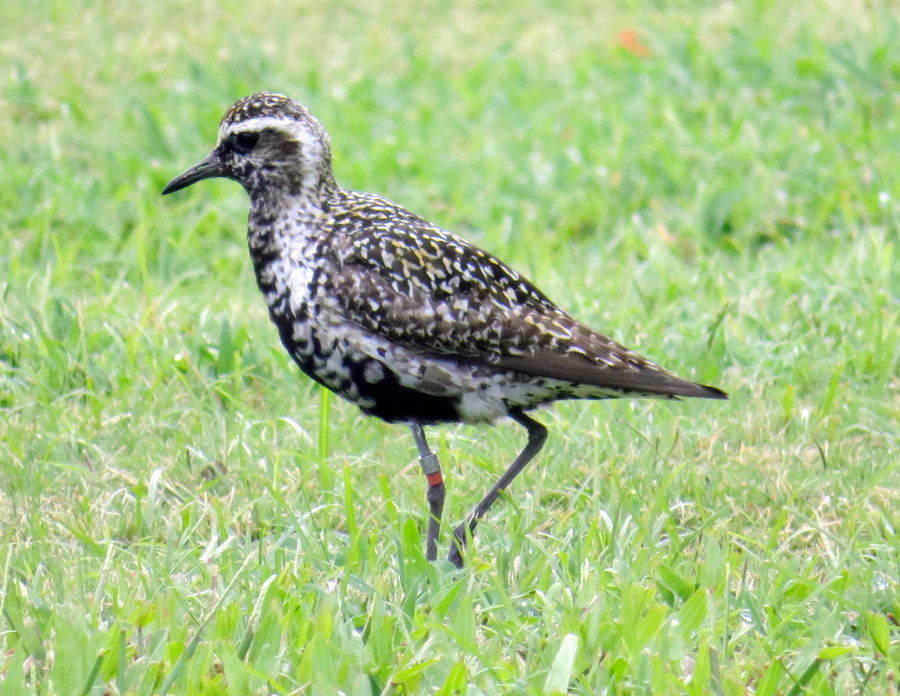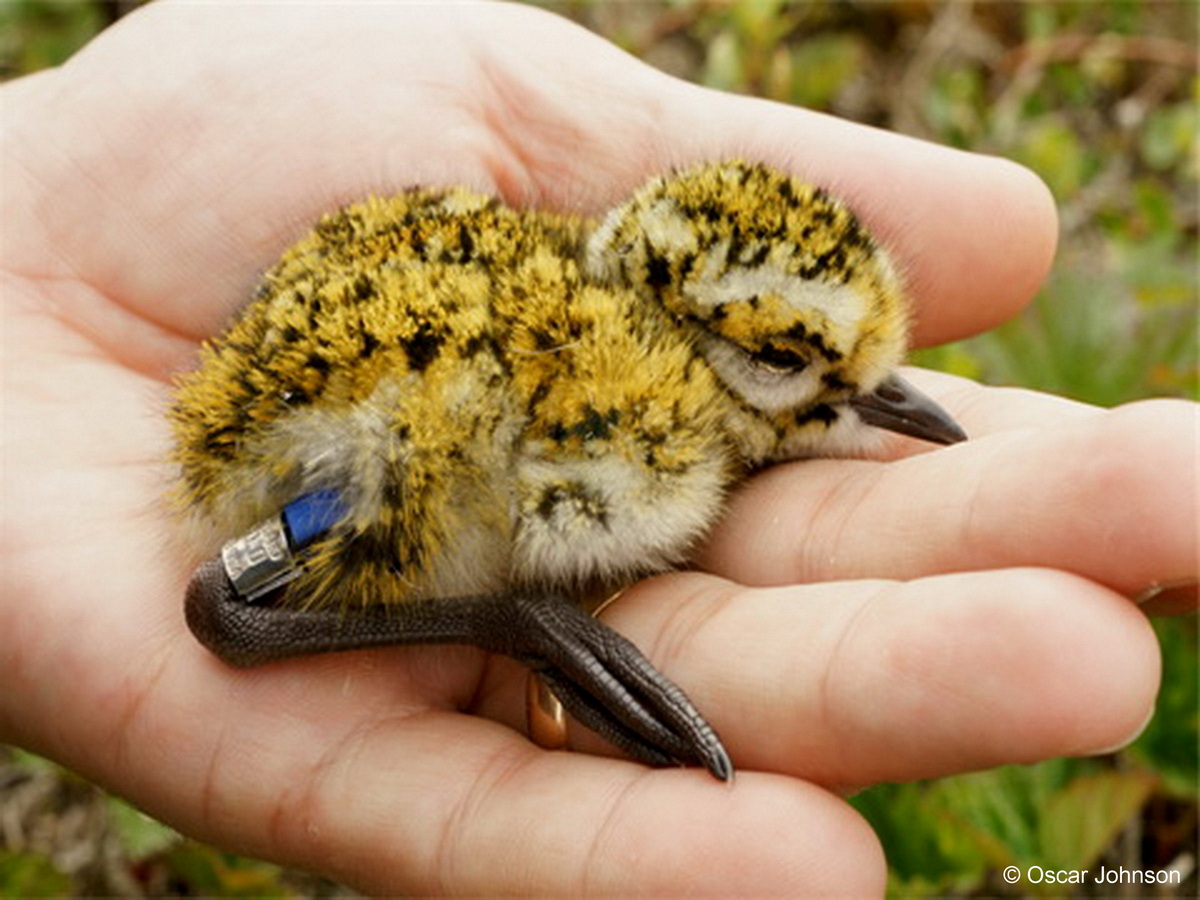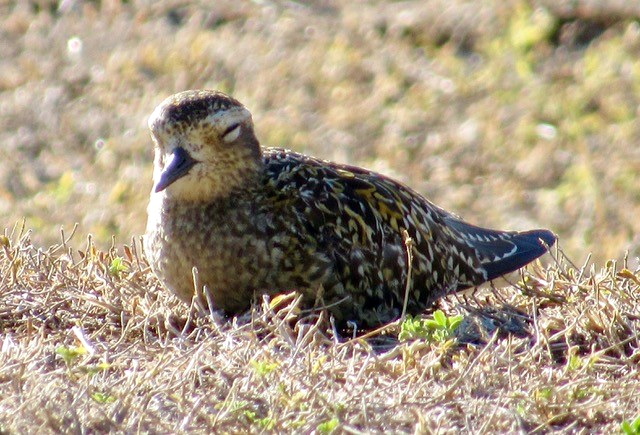
Mr. X lost his upper red leg band since last spring. The bird is active, foraging in his usual territory in Punchbowl. No other birds in the area are banded. August 27, 2021 © Sigrid Southworth
September 9, 2021
We could all use something to cheer about these days. Here’s a good one: Mr. X has returned.
Mr. X is a Kolea banded in Honolulu’s Punchbowl Cemetery on April 12, 2004, making the bird nearing a longevity record for Pacific Golden-Plovers. Longtime plover fan and volunteer counter, Sigrid Southworth, spotted the bird foraging in his long-held territory on August 27th. (Sig named the grand old bird Mr. X, because his territory is in section X of the alphabetically-organized cemetery.) That makes the bird at least 19 years, 4 months old.
The current age record is Mr. Bellows, another male Kolea banded at Bellows Air Force station. That bird lived at least 21 years, 3 months.
For years, plover expert, Wally Johnson has monitored Kolea in the National Memorial Cemetery of the Pacific, often called Punchbowl because it’s located inside Punchbowl Crater, an extinct Oahu volcano. With 116 acres of meticulously mowed grass, and light human traffic, Punchbowl is plover paradise.
When we started Hawaii’s Kolea Count in 2020, Sig joined in, reporting between 70 and 100 Kolea in the cemetery, the count varying with weather conditions and number of people paying their respects. Sig had a joyful moment in March when she spotted, and photographed, a bird with bands on its leg. (See https://www.koleacount.org/hawaiis-birds-hold-their-own-easter-parade/) Wally identified the bird by the three bands of red-aluminum-red that he placed on the bird in Punchbowl when it was at least 1 year and 10 months old.
It’s possible the bird was older. Plover experts can only determine a first-year bird during its first fall and winter in Hawaii, because its wing feathers are then distinct. Come spring, after the birds molt into breeding colors, all wing feathers look alike, making it impossible to know an individual’s age.
Unless, of course, the Kolea is one of the few wearing ID bands.

Mr. X in his territory in March, 2021 with all three leg bands. ©Sigrid Southworth.
You might have heard the hooting and hollering from Maine (where Wally is visiting), me (in Kailua), and Sig (in Honolulu) last week, when Sig informed us that she spotted Mr. X in his usual territory on August 27th.
No one knows how many of our Kolea are this long-lived. Only by placing bands on their legs, do we know their age for sure, and even then, there’s guessing involved in any bird other than a first-year hatchling.

Researchers can place adult-sized leg bands, shown here, on newly hatched Kolea chicks. The youngsters begin foraging for insects and berries soon after hatching. Parents warm and protect their offspring, but do not feed them. Near Nome, Alaska © Oscar Johnson.
Banding chicks in Alaska immediately after they hatch would be accurate age-wise, and it’s possible because plover chicks hatch with adult-sized legs and feet. But plovers’ remote tundra nesting sites, as well as the guarded behavior of parent birds, makes banding chicks in the Arctic extremely difficult. Catching a plover is hard enough here in Hawaii where the birds are used to people and not hiding chicks. Once a plover is alerted to danger, those two mighty wings that propel the bird 6,000 miles round-trip each year work well in avoiding capture. Kolea also have excellent eyesight, making them good at spotting researchers, whom the birds view as potential predators.
Thank you for continuing to report new Kolea arrivals. This summer’s offspring will be arriving in Hawaii through November, and the official head count begins December 1st.
In the meantime, this is a good time to celebrate Wally’s decades-long banding efforts, Sig’s eagle eye and fine photography, and of course, Mr. X himself, an excellent ambassador for his species.

Snoozing in Diamond Head Crater after a 3,000 mile journey. September, 9, 2021 © Pat Moriyasu

Kolea fan, Roger Kobayashi, emailed this photo of about 50 Kolea at the field next to Tripler Army Hospital on September 4, 2021, writing that he counted about 80 individuals there, some not shown in this photo. Presumably, the birds has just landed and later dispersed.